
Launching today in the US and Canada, Quilt’s new heat pump system merges high functionality with aesthetic appeal, aiming to entice homeowners to transition to low-carbon heating and cooling. Designed by Studio Mike and Maaike in collaboration with the California start-up Quilt, the system features both outdoor and indoor units that emphasize modern, architectural aesthetics. The outdoor unit boasts a sleek, matte black design, while the indoor unit resembles built-in cabinetry, complete with a paintable front panel and integrated lighting. Accompanying these units is the Quilt Dial, a room thermostat, and a user-friendly app for comprehensive control and energy tracking. The overall design ensures the system is not only efficient but also a visually pleasing addition to any home.

Co-founder and CEO Paul Lambert highlights the company’s commitment to thoughtful design and a seamless user experience, a sentiment echoed by Mike Simonian of Mike and Maaike. Simonian noted that previous slow adoption rates of heat pumps in the US were partly due to uninspired designs and complex user interfaces. In response, their studio focused on creating an intuitive, aesthetically pleasing, and cohesive system that integrates effortlessly into home environments. The design includes an architectural outdoor unit that blends with its surroundings and customizable indoor units, available in oak veneer or paintable white covers, to match various interior decors. Additionally, the Quilt Dial’s angled screen enhances readability, and the use of advanced technology like millimeter wave radar sensors ensures optimal energy use. This design-led approach positions Quilt as a pioneering force in the transition to sustainable home climate solutions.



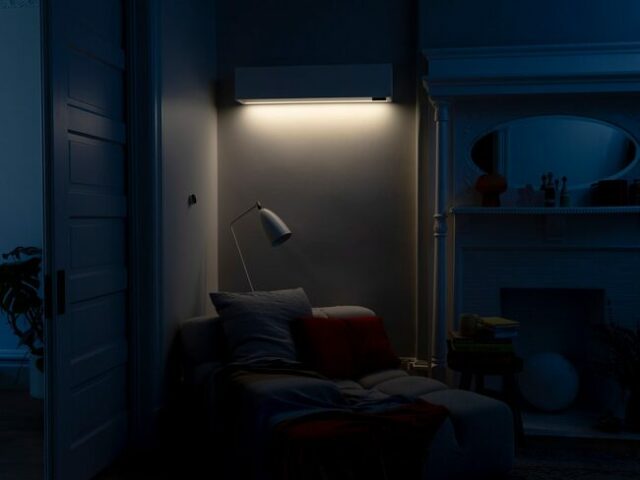

Camping or sleeping outdoors can be daunting, especially for those who prefer not to sleep directly on the ground. The Helinox Tactical Cot Tent offers a solution for campers who desire more comfort and separation from the elements and insects. This innovative accessory transforms a standard cot into a fully enclosed, elevated sleeping space. Available in both mesh and fabric options, it ensures breathability and durability. Weighing just 3.5 pounds and packing down to a compact 22.5” x 8” x 8” size, the Tactical Cot Tent is easy to transport and set up, making it a practical choice for those reluctant to rough it outdoors.

The Tactical Cot Tent is designed for ease and security. It features shock-corded poles and pole clips for quick assembly, reinforced corners, ties, and corner sleeves for added stability, and four J-stakes to anchor it securely to the ground. Inside, it provides ample storage with four mesh pockets and four gear loops. For rainy conditions, the Tactical Cot Tent Solo Fly attaches seamlessly with velcro tabs and additional J-stakes, featuring strategically placed doors and ventilation windows to enhance airflow and reduce condensation. This thoughtful design makes the Helinox Tactical Cot Tent an excellent option for anyone seeking a more comfortable and isolated sleeping experience while camping.









A little bit of sparkle can elevate any outfit. But what if, instead of wearing shiny, reflective accessories, you were your source of light? Patrick Cassidy is a Washington-based crafter and owner of LaserWoodLights, where he offers laser-cut wood items that glow from within. What began with lamps and lanterns was eventually translated into a pair of beautiful Light Up Wood Earrings—which evoke the soft amber light of vintage street lamps or stained glass windows at dawn. The Light Up Wood Earrings are battery-powered and can be adjusted by screwing them tight or loose to turn them on or off. These drop earrings work with an LED inside, which is powered by an LR41 replaceable battery, to illuminate the wearer. The light inside can also be customized, as Cassidy offers the earrings in a standard amber glow as well as blue, pink, and red options. This makes them ideal for music festivals, special occasions, or even sporting events.

If earrings are not your thing but you want to give light-up accessories a go, Cassidy also offers a Lil’ Lantern Necklace. Also made of laser-cut wood, it’s discreet enough for any outfit but bright enough to make you noticeable in a crowd. For a more striking piece, you can check out the Pendant of Light & Form, a statement-making necklace that changes between 16 different colors. While Cassidy began offering unique lamps as an alternative to common lighting solutions, the way his accessories turn those who wear them into beacons of light has a poetic feeling to it. “The intention was a light that creates a warm glow, looks cool, from wood, for an affordable price,” he writes. “Thus LaserWoodLights was born and has been producing wooden lighting solutions to illuminate rooms ever since.” To stay up to date with any new releases from LaserWoodLights, make sure to visit their Etsy store.

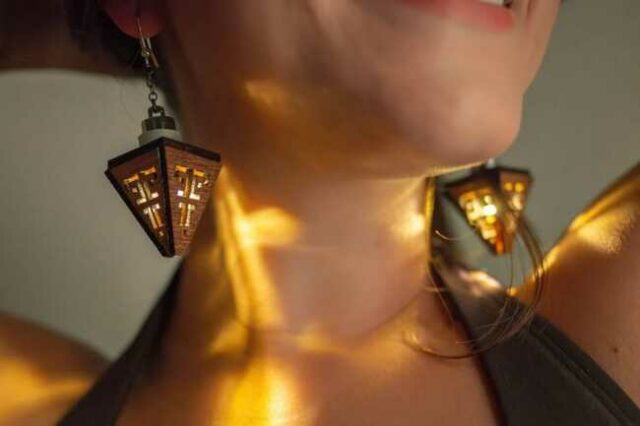

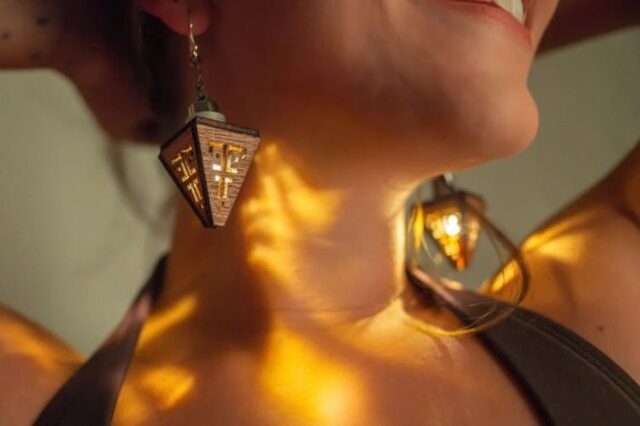
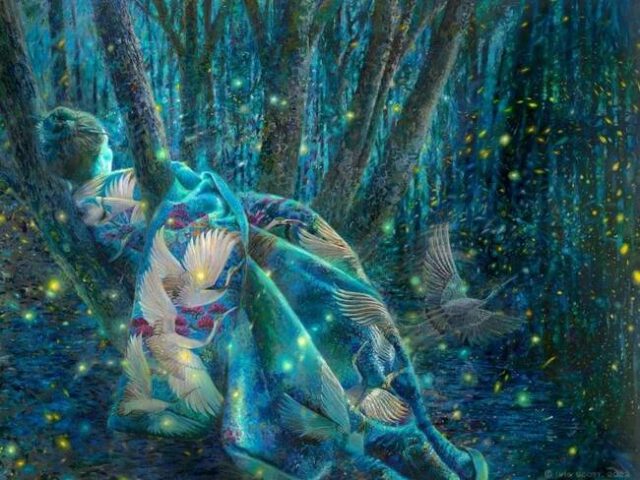
Innovative finger painter Iris Scott has unveiled an evocative new artwork in her signature style titled Goddess of Dreams. This mesmerizing piece captures the serene image of a woman resting against a tree in a forest aglow with the ethereal light of fireflies. The woman’s dress, intricately embroidered with cranes, features a stunning illusion where one of the birds appears to break free from the fabric and soar into the air. Set on a grand 8-foot by 6-foot canvas, the scene is brought to life through Scott’s unique blend of finger painting and brushwork. Particularly striking are the fireflies, whose radiant presence is enhanced by the manipulation of oil paints using compressed air, adding a dynamic texture that contrasts beautifully with the more detailed elements rendered by brush.
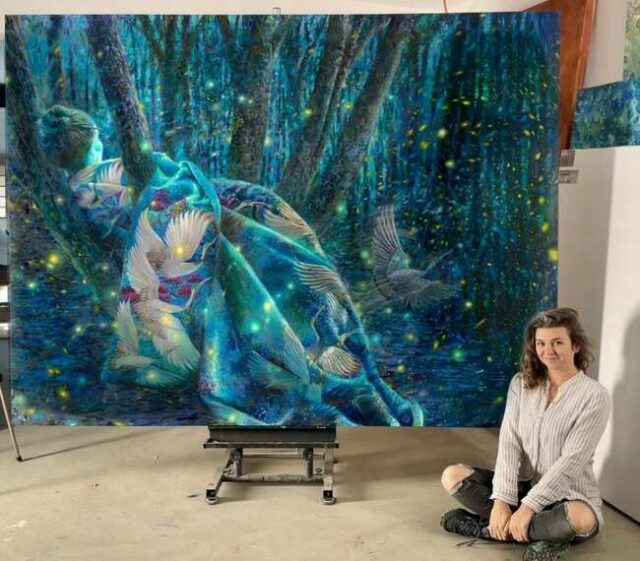
Scott’s Goddess of Dreams is a testament to her ability to merge imagination with reality, a theme she emphasizes through the enchanting imagery and intricate techniques employed in the piece. The use of finger painting for broader strokes and texture, combined with delicate brushwork for facial features and dress embroidery, showcases her innovative approach to oil painting. This harmonious blend of methods not only underscores the fantastical elements of the scene but also highlights Scott’s versatility and skill as an artist. Reflecting on the painting, Scott describes it as a representation of the thin line between dreams and reality, suggesting that this boundary can be effortlessly crossed in the right frame of mind. The original artwork, along with prints, is available for purchase on her website, inviting art enthusiasts to bring a piece of this dreamlike world into their own spaces.

Swimply, often dubbed the ‘Airbnb of Pools,‘ is offering a unique summer dream job that promises a blend of travel, content creation, and aquatics. The company, which facilitates rentals of private pools, hot tubs, saunas, and more, is searching for a ‘Chief Pools Officer.‘ This lucky individual will traverse all 50 states, diving into various pools and creating engaging video reviews for each location. With a potential earning of up to $100,000, this position not only pays well but also offers the chance to explore and review a diverse array of swimming spots across America. To apply, candidates must be over 18, book a pool through Swimply, and submit a video review by June 15th, tagging the company on social media using @swimply and #SwimplyDreamJob.

Swimply emphasizes the importance of their Chief Pools Officer as a key influencer and expert in identifying the best private pools in the country. As part of their job, the chosen content creator will be responsible for showcasing the variety and appeal of Swimply’s offerings through engaging social media content. The role comes with a base salary of $50,000, with the potential to double that amount through performance bonuses tied to content engagement and feedback. Each applicant will also undergo a follow-up interview with Swimply’s CEO, Derek Callow, and a unique “swimming screen test” to ensure they are the perfect fit for this aquatic adventure. This dream job not only promises financial rewards but also the opportunity to become the face of Swimply’s community-driven pool rental marketplace.

In a significant win for conservation, the Kozmetsky family has chosen to sell their historic RGK Ranch in Travis County, Texas, to be transformed into a public park, rather than accepting a far more lucrative offer from developers. Situated just 30 minutes from Austin’s bustling tech sector and cultural hotspots, the 1,507-acre ranch was sold for $90 million, a stark $40 million less than what developers were willing to pay. The property, which had permits for extensive residential and commercial development, is now preserved for public use, ensuring that the natural beauty and biodiversity of the Hill Country remain intact. This decision was greatly influenced by the family’s deep-rooted connection to the land and their desire to honor the legacy of George Kozmetsky, who had made significant entrepreneurial and philanthropic contributions to the region.

The RGK Ranch, once slated to become a dense urban development, will now join the ranks of Hamilton Pool Preserve and Reimers Ranch Park, creating a contiguous protected area of 5,430 acres in the heart of the rapidly growing Travis County. This effort is part of a broader initiative, facilitated by the Nature Conservancy and supported by the Proposition B Parks Bond Measure passed by Austin voters, to safeguard the region’s unique ecosystems and recreational spaces. With plans to expand the protected areas to a combined total of 8,600 acres, the new park will provide critical wildlife corridors and hiking trails, enhancing the public’s access to nature while preserving the environmental integrity of the Hill Country. The Kozmetsky family retains 90 acres of the original ranch, maintaining personal ties to the land, and the county holds first-refusal rights for any future sale, ensuring the long-term preservation of this cherished landscape.

Polish architect Robert Konieczny, the visionary founder of KWK Promes, is set to transform Poznań’s residential landscape with the groundbreaking Aura project. This innovative building, distinguished by a facade enveloped in greenery, will feature 140,000 plants, establishing a harmonious relationship with its natural surroundings. The design philosophy behind Aura focuses on minimizing environmental disruption while enhancing the ecosystem, with the structure rising organically from the terrain to mimic a verdant hillside. KWK Promes has integrated advanced global research and technologies into the project, enabling diverse plant species to thrive on the building facade. This lush vegetation not only offers aesthetic pleasure but also practical benefits such as temperature regulation and fresh produce, creating a microclimate that enhances living conditions year-round.

The Aura project signifies a pioneering achievement in Poland’s architectural scene, facilitated through close collaboration with Poznań University of Technology and the University of Life Sciences. The building’s innovative facade features a vertical garden supported by a specially designed structure that includes an air gap for natural insulation and an automated irrigation system that primarily uses collected rainwater. Inside, investor Piotr Voelkel has enlisted artist Alicja Biała to bring a unique artistic flair to the lobby. Biała’s work, inspired by local flora threatened by habitat loss and climate change, includes a sculptural plant lamp and nature-inspired reliefs. She has also developed custom glazes for her sculptures using soil from the Wielkopolska region, including the Aura construction site, ensuring that each piece embodies the local environment’s unique mineral composition. Through these thoughtful integrations, Aura not only redefines urban living but also showcases a deep commitment to sustainability and environmental stewardship.






Take a moment to envision Earth 250 million years from now, a world dramatically different from today. As continental drift continues its relentless course, the scattered continents we know today will once again converge into a supercontinent. The process is far from uniform, leading to various possible configurations. One potential scenario, Aurica, envisions a vast equatorial landmass, while Amasia would see the continents clustering around the North Pole, leaving Antarctica isolated at the South Pole. Novopangea proposes the closure of the Pacific Ocean, while Pangea Ultima (or Proxima) imagines a configuration where the continents coalesce around a central ocean. This potential supercontinent, Pangea Proxima, harkens back to ancient Pangea, reminding us that Earth’s surface is perpetually reshaping itself through tectonic forces. Continue reading “Take a Shocking Look At What Earth Will Look Like 250 Million Years From Now” »

Aston Martin has entered the realm of luxury real estate with a remarkable debut: the sail-shaped Aston Martin Residences Miami. This skyscraper, positioned at 300 Biscayne Boulevard Way, near the Miami River, stands at an impressive 817 feet, securing its status as the tallest residential building south of New York City. The project, first announced in 2016 and completed in 2021, marks Aston Martin’s first venture into real estate. The design, reminiscent of the iconic Burj Al Arab, was a collaborative effort between Aston Martin’s design team, architect Rodolfo Miani of Bodas Mian Anger, and G&G Business Development. The building’s steel and sail-like glass exterior pay homage to its marina surroundings, while its unique curvilinear form and substantial terrace with an infinity pool near the top add to its allure. The structure boasts four interconnected levels between the 52nd and 55th floors, featuring high-end amenities such as a two-floor fitness center with ocean views, an art gallery, two movie theaters, a virtual golf simulator, a business center, conference rooms, a kids’ playroom, and a full-service spa, beauty salon, and barber shop.

Inside, the Aston Martin Residences Miami seamlessly integrates the automaker’s design ethos, incorporating luxurious touches like keyless doors in Kestrel tan leather, prominent door handles, and carbon fiber reception desks. Spanning 66 floors, the tower houses 391 luxury residential units, including one to five-bedroom apartments, lavish penthouses, and a “Unique Triplex Penthouse” that covers 2526 square meters over three floors. Residents can enjoy a variety of amenities such as private butler services, an art gallery, and a spa. The interiors offer a selection of elegant colors and furnishings, ensuring a personalized luxury living experience. This striking skyscraper not only enhances Miami’s skyline but also represents a significant milestone in Aston Martin’s expansion into the luxury real estate market, aligning with other automotive giants like Mercedes-Benz and Bugatti in blending high-performance design with opulent living spaces.































































